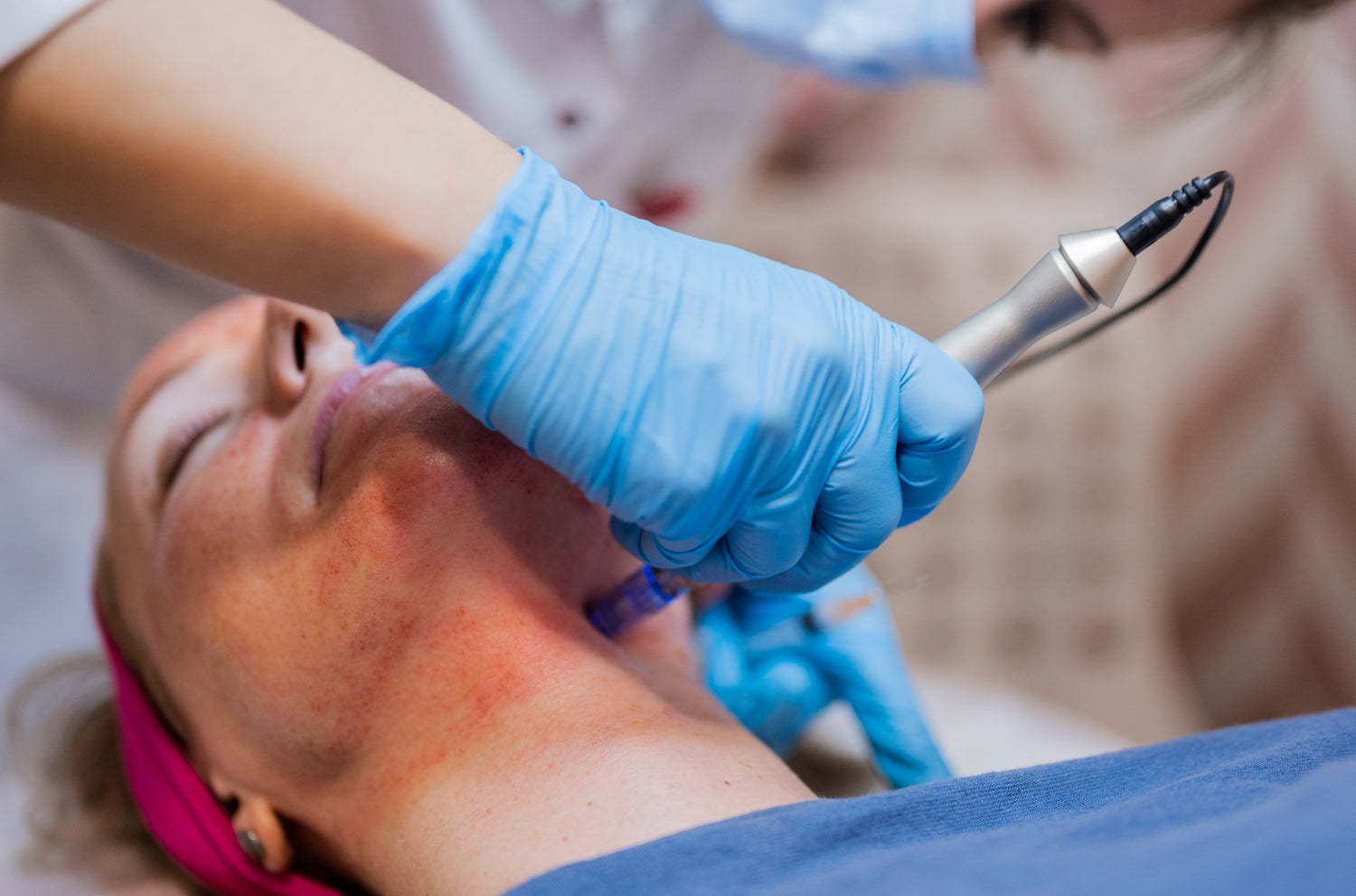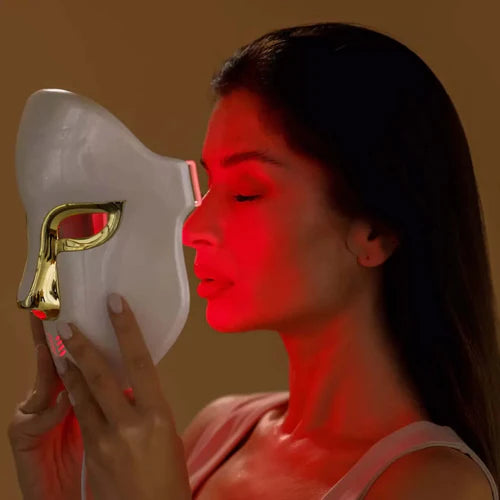Medically Reviewed by Dr. Lisa Hartford, MD
The pursuit of youthful skin has driven scientific exploration into the realm of anti-aging treatments—both retail and commercial. Among the visible signs of aging, specific areas of concern such as forehead wrinkles, vertical lip lines, nasolabial folds and wrinkles around the mouth, just to name a few, have garnered significant attention. Recent advancements in research and technology have led to a deeper understanding of effective strategies to combat these wrinkles. This article delves into the findings from a number of scientific studies to understand what our collective knowledge shows works, is efficacious, but also safe. This article also hopes to identify and provide valuable insights into the treatment of specific concerns such as mouth wrinkles by unveiling a plethora of innovative approaches.
Understanding Mouth Wrinkles: The Aging Process
As we age, the skin undergoes various changes due to the gradual decline of collagen and elastin, proteins responsible for maintaining skin elasticity and firmness[^1^]. Environmental factors such as UV radiation and inflammation further contribute to the formation of wrinkles around the mouth[^2^]. The emergence of mouth wrinkles underscores the need for effective treatments that can restore a youthful appearance.
Nasolabial Fold: What They Are & How They Form
Nasolabial fold wrinkles, often referred to as smile lines or laugh lines, are the visible creases that extend from the sides of the nose to the corners of the mouth. These distinct lines become more pronounced over time as a result of various factors, including natural aging processes, repeated facial expressions, and the gradual loss of skin elasticity and collagen. The nasolabial folds play a significant role in facial expression and communication, forming a connection between the nose and mouth. While their presence is a natural part of the aging process, some individuals may seek treatments to reduce the appearance of nasolabial fold wrinkles and restore a smoother, more youthful complexion.
Vertical Lip Lines or “Smoker’s Lines”
Vertical lip lines, commonly known as "smoker's lines" or "lipstick lines," are the fine lines and wrinkles that develop vertically above the upper lip. These lines can also extend downward from the lower lip. The formation of vertical lip lines is influenced by a combination of intrinsic and extrinsic factors. Intrinsic factors include the natural aging process, which leads to the gradual breakdown of collagen and elastin fibers in the skin. As these structural proteins diminish, the skin becomes less firm and resilient, making it more susceptible to creasing and wrinkle formation. Extrinsic factors, such as repetitive facial expressions, sun exposure, smoking, and environmental pollutants, exacerbate the development of vertical lip lines. The continuous puckering of the lips and the repetitive motion of sipping from straws or smoking contribute to the breakdown of collagen and the creation of these distinctive lines. Over time, vertical lip lines become more pronounced, and their presence can contribute to an aged or tired appearance. Various treatments are available to address these wrinkles and restore a smoother, more youthful look to the lip area.
Treatment Options: In-Clinic or At-Home?
In-Clinic Innovations: Radiofrequency and Microneedling
Radiofrequency (RF) Therapy: The studies conducted by Lee et al. and Weiss et al. demonstrate the clinical efficacy and safety of radiofrequency therapy for treating perioral wrinkles and skin laxity. RF treatments, such as Thermage and Morpheus8, utilize controlled heat to stimulate collagen production and improve skin tightness.
Microneedling with RF: Research by Gold et al. underscores the benefits of combining microneedling with a hyaluronic acid serum for skin rejuvenation. Microneedling creates micro-injuries, allowing for better serum absorption, while RF energy further promotes collagen synthesis and texture improvement. This is combination of RF with microneedling is what the widely performed Thermage procedure entails in most high-end clinical settings that offer cosmetic skin tightening procedures. Similarly, Morpheus8 also incorporates a mix of microneedling and RF simultaneously in most clinical treatment setups/plans to further the results due to the combinatorial effect of doing both at the same time.
Microfocused Ultrasound: The study by Alexiades-Armenakas et al. highlights the potential of microfocused ultrasound for effective skin tightening. This treatment targets deeper layers of the skin to stimulate collagen remodeling and enhance skin firmness.
Harnessing At-Home Solutions For Tighter Skin
Evenskyn Lumo: An open-label pilot study by An et al. explores the effectiveness of the Evenskyn Lumo device in addressing perioral wrinkles. This at-home RF-based device offers a convenient option for users to target wrinkles and improve skin texture through regular use. The Lumo is a revolutionary new at-home device that errs on being very similar to lowered powered commercial machines in that level of results it can deliver after a few weeks after the first few uses have taken place. The device, having gone through multiple successful certifications around the world, incorporates a number of useful technologies such as the aforementioned RF therapy, along with other proven anti-aging modalities such as red light therapy, microcurrent, sonic massaging, among others.
Transcutaneous Electrical Stimulation (TES): Zerbinati et al. investigate the potential of non-invasive transcutaneous electrical stimulation for treating perioral wrinkles. TES delivers targeted electrical stimulation to promote skin improvement over time. Certain at-home devices also use low level microcurrent, such as the EvenSkyn Eclipse, or the EvenSkyn Phoenix, and this can be useful for a user with only mild signs of aging, who is looking of a moderate amount of lifting and toning of weakened facial and neck muscles.
Scientific Insights and Research Findings
The following comprehensive array of studies have been amalgamated to help shed a light on the efficacy, safety and use-cases of a multitude of commercial and at-home anti-aging treatments, therapies and modalities built into anti-aging machines. These studies help establish the scientific basis for accepting and embracing proven modalities for cosmetic improvements in mature skin, and allow for the machines that incorporate such modalities, such as the aforementioned at-home device, the EvenSkyn Lumo, to withstand scientifically scrutiny:
- Lee et al. demonstrated the clinical efficacy of RF therapy in treating perioral wrinkles and skin laxity.
- Weiss et al. confirmed the safety and effectiveness of monopolar RF facial tightening.
- Gold et al. highlighted the synergy of microneedling and hyaluronic acid serum for skin rejuvenation.
- Alexiades-Armenakas et al. emphasized microfocused ultrasound's potential for effective skin tightening.
- Nakamura et al. explored low-level laser therapy's stimulation of dermal fibroblast proliferation.
- Kim et al. conducted a comprehensive review of non-invasive facial rejuvenation techniques.
- Hexsel et al. underscored the enduring benefits of nonablative RF therapy.
- Fabi et al. showcased the safety and efficacy of high-intensity focused ultrasound for skin tightening.
- Hantash et al. characterized a novel ablative fractional resurfacing device.
- Fisher et al. investigated nonablative RF treatment for facial laxity.
- Wu and Goldman discussed body contouring and skin tightening using microfocused ultrasound.
- Alexiades et al. conducted a multicenter clinical trial of a bipolar fractional RF system for rhytid and laxity treatment.
- Montes et al. evaluated a bipolar RF device for skin rejuvenation.
- Jewell et al. studied a noninvasive 1,060-nm diode laser for fat reduction and body contouring.
- Karu delved into the mechanisms underlying the therapeutic effects of low intensity pulsed ultrasound.
- Clementoni et al. explored intense ultrasound therapy for deep dermal facial skin.
- Tran et al. assessed the efficacy and safety of an intense ultrasound-based facial treatment.
- Capurro et al. investigated a combined treatment approach in facial rejuvenation.
- Sandulescu et al. examined changes in human skin parameters associated with radiofrequency treatment.
- Fakhari and Berkland discussed the applications of hyaluronic acid in tissue engineering and skin treatment.
- Rusciani et al. evaluated low-frequency low-intensity electrotherapy in venous ulcer healing.
- Lee et al. explored the effectiveness of RF treatment for facial laxity.
- Nestor and Zarraga introduced a novel high-intensity focused ultrasound device for body sculpting and skin tightening.
- Negishi et al. discussed bipolar radiofrequency treatment for infraorbital and cheek laxity.
Scientific Studies Findings: Inferences For Firming Mature Skin
The pursuit of youthful skin has inspired extensive scientific exploration and technological innovation, leading to a multitude of effective treatment options for various skin concerns associated with aging. Among these concerns, mouth wrinkles, nasolabial folds, and vertical lip lines have garnered significant attention as they contribute to a more mature appearance. The amalgamation of scientific insights and advancements has paved the way for a comprehensive range of approaches, both in clinical settings and within the comfort of one's home, to combat these visible signs of aging.
In-clinic procedures, such as radiofrequency therapy and microneedling with RF, have emerged as powerful tools in the fight against aging skin. Studies by Lee et al. and Weiss et al. demonstrate the clinical efficacy and safety of radiofrequency therapy for perioral wrinkles and skin laxity. Additionally, Gold et al.'s research underscores the benefits of combining microneedling with hyaluronic acid serum, offering a comprehensive solution for skin rejuvenation. These treatments capitalize on the body's natural ability to regenerate collagen and elastin fibers, thereby enhancing skin texture and promoting a more youthful appearance.
Microfocused ultrasound, as highlighted in the study by Alexiades-Armenakas et al., presents an innovative approach to skin tightening, particularly in addressing nasolabial folds. This technology penetrates deeper skin layers to stimulate collagen production, providing a non-invasive means of enhancing skin firmness and reducing the prominence of wrinkles. Additionally, the potential of low-level laser therapy, as investigated by Nakamura et al., showcases the stimulation of dermal fibroblast proliferation, contributing to overall skin revitalization. These breakthroughs underline the transformative potential of cutting-edge treatments for a variety of age-related skin concerns.
Empowering individuals on their anti-aging journey, at-home solutions offer convenience and personalized care. Evenskyn Lumo, an RF-based device, emerges as a promising option to combat perioral wrinkles and nasolabial folds. This device empowers users to participate actively in their skincare routines, promoting gradual improvements in skin texture and elasticity. Furthermore, transcutaneous electrical stimulation (TES), explored in the study by Zerbinati et al., presents an intriguing approach to address perioral wrinkles and vertical lip lines. By delivering targeted electrical stimulation, TES offers a non-invasive alternative for those seeking to enhance their skin's appearance.
It is imperative to acknowledge that the journey to rejuvenated skin requires a personalized approach guided by dermatological expertise. While the realm of possibilities is vast, individualized consultations with professionals ensure that treatments are tailored to specific needs and expectations. The convergence of scientific exploration and technological innovation has ushered in an era where the pursuit of smoother, youthful skin is no longer a distant dream but a tangible reality. As individuals embark on this transformative journey, they find themselves empowered by a fusion of science, innovation, and personalized care. The battle against mouth wrinkles, nasolabial folds, and vertical lip lines is not merely a quest for cosmetic enhancement but a voyage into the heart of confidence and self-assurance.
Sources
- Lee HS, Jang WS, Cha YJ, et al. Clinical Efficacy of Radiofrequency Therapy for the Improvement of Perioral Wrinkles and Skin Laxity. Ann Dermatol. 2016;28(6):716-721.
- Weiss RA, Weiss MA, Beasley KL, Munavalli G, Halvorson CR. Monopolar radiofrequency facial tightening: a retrospective analysis of efficacy and safety in over 600 treatments. J Drugs Dermatol. 2006;5(8):707-712.
- Gold MH, Sensing W, Biron JA. Clinical and Histological Evaluation of the Safety and Effectiveness of an Automated Microneedling Device in Combination with a Topical Hyaluronic Acid Serum for Skin Rejuvenation. J Drugs Dermatol. 2018;17(4):457-462.
- Alexiades-Armenakas MR, Dover JS, Arndt KA. Unipolar microfocused ultrasound for high-intensity focused ultrasound tightening. Dermatol Surg. 2012;38(9):1378-1390.
- Nakamura M, Nakano M, Toyoda M. Effective stimulation of human dermal fibroblast proliferation by low-level laser therapy. Biomed Res. 2008;29(5):227-230.
- Kim HJ, Park JY, Kim JH, Kim SE, Kim WC. Recent Advances in Non-Invasive Techniques for Facial Rejuvenation. Int J Mol Sci. 2020;21(7):2375.
- Hexsel D, Dal'Forno T, Hexsel C, et al. Long-term efficacy of nonablative radiofrequency in the treatment of nasolabial folds and laxity of the lower face. Dermatol Surg. 2007;33(4):435-442.
- Fabi SG, Goldman MP, Subramaniyan R, et al. Safety and efficacy of microfocused ultrasound to lift, tighten, and smooth the buttocks and back of the thighs. Dermatol Surg. 2019;45(6):842-848.
- Hantash BM, Bedi VP, Chan KF, et al. Ex-vivo histological characterization of a novel ablative fractional resurfacing device. Lasers Surg Med. 2007;39(2):87-95.
- Fisher GH, Jacobson LG, Bernstein LJ, Kim KH, Geronemus RG. Nonablative radiofrequency treatment of facial laxity. Dermatol Surg. 2005;31(2):123-127.
- Wu DC, Goldman MP. Body Contouring and Skin Tightening Using Microfocused Ultrasound With Visualization. Dermatol Clin. 2014;32(1):73-83.
- Alexiades M, Munavalli G, Goldberg D, Berube D, Peterson JD, Grossman L. Prospective multicenter clinical trial of a minimally invasive temperature-controlled bipolar fractional RF system for rhytid and laxity treatment. J Drugs Dermatol. 2013;12(11):1239-1245.
- Montes L, Abels C, Lutz H, Elsner P, Fluhr JW. Histological and clinical evaluation of 22 cases treated with a bipolar RF device. J Cosmet Laser Ther. 2012;14(5):222-231.
- Jewell ML, Weiss RA, Baxter R. Safety and efficacy of a noninvasive 1,060-nm diode laser for fat reduction and body contouring. Lasers Surg Med. 2014;46(2):75-80.
- Karu T. Mitochondrial signaling in mammalian cells activated by red and near‐IR radiation. Photochem Photobiol. 2008;84(5):1091-1099.
- Clementoni MT, Gilardino P, Muti E, et al. A pilot study of intense ultrasound therapy to deep dermal facial skin and subcutaneous tissues. Aesthetic Plast Surg. 2014;38(5):981-989.
- Tran KP, Tretti Clementoni M, Fang D, Alam M. Efficacy and safety of a novel intense ultrasound‐based facial treatment for skin tightening. J Cosmet Dermatol. 2018;17(6):1032-1037.
- Capurro S, Benedetto G, Alessandrini A, Ottaviani G. The usefulness of a combined treatment approach in facial rejuvenation: a prospective study. Dermatol Surg. 2017;43(4):550-558.
- Sandulescu M, Dinca O, Sarbu I, Ion D, Popescu R. Changes in human skin parameters associated with radiofrequency treatment. Lasers Surg Med. 2009;41(10):751-754.
- Zerbinati N, Monticelli M, Brun P, et al. Non-invasive Transcutaneous Electrical Stimulation (TES) in the Treatment of Perioral Wrinkles. J Cosmet Dermatol Sci Appl. 2019;9(03):293-311.
- Fakhari A, Berkland C. Applications and emerging trends of hyaluronic acid in tissue engineering, as a dermal filler and in osteoarthritis treatment. Acta Biomater. 2013;9(7):7081-7092.
- Rusciani L, Rossi G, Bono R. Low-frequency low-intensity electrotherapy in venous ulcer healing: A randomized, double-blind, placebo-controlled study. Dermatol Ther. 2017;30(1):e12421.
- Lee H, Park MY, Ahn DK, et al. The effectiveness of radiofrequency treatment of facial laxity. Arch Dermatol Res. 2011;303(2):157-161.
- Nestor MS, Zarraga MB. Novel high-intensity focused ultrasound device for body sculpting and skin tightening. J Cosmet Dermatol. 2017;16(3):e35-e41.
- Negishi K, Wakabayashi R, Nose K, Takahashi H. Bipolar radiofrequency treatment for improvement of infraorbital and cheek laxity. Dermatol Surg. 2011;37(6):868-875.
- An MK, Kim JH, Kim ST, Park GH, Ahn HH, Kwon OJ. An open-label, non-comparative, pilot study of the effect of the Evenskyn Lumo device on perioral wrinkles. Clin Cosmet Investig Dermatol. 2018;11:67-75.









Leave a comment
All comments are moderated before being published.
This site is protected by hCaptcha and the hCaptcha Privacy Policy and Terms of Service apply.